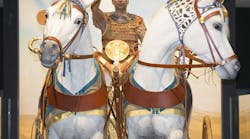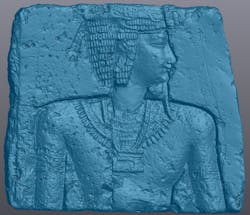Using 3D-scanning technology from Creaform, experts from the Milwaukee School of Engineering (MSOE) invented a way to let visitors observe ancient Egyptian artifacts up close. Over the course of three days, they scanned over 30 items at the Milwaukee Public Museum (MPM), including a life-sized sculpture of King Tutankhamun on his horse-drawn carriage, so that visitors can observe astonishing details from 3D virtual models on their tablets.
One of the museum’s first permanent exhibits in ten years, Crossroads of Civilization serves to “explore how the ancient civilizations of Africa, Europe and Asia came together to form an epicenter of complex culture,” according to the MPM website. It includes over 200 artifacts and two mummies with CT scans of their faces. It has a special focus on King Tut, who ruled in Egypt in the mid-1300 BC starting at the age of nine.
Based off of CT scans on his mummy, MPM’s sculpture accurately portrays Tut’s body type and facial structure. Embellishments on his armor and horse-drawn carriage are true to ancient chariots found in Egypt and artifacts in his tomb. Using the Go!SCAN 20 and the Go!SCAN 50, Vince Anewenter and Jordan Weston from MSOE’s Rapid Prototyping Center (RPC) scanned clothing and riding gear layer-by-layer. The Go!SCAN 50 was used to create a general contour map by recording the way the sculpture reflects light.
The specialists then switched to the Go!SCAN 20 in its "Natural Features” mode to capture more intricate details at a higher resolution and in full color. After scanning, the experts resolved any holes in the images using post-treatment software called VXmodel. They then transferred the 2D watertight color images to multimedia software, and projected them onto a 3D model.
In addition, a "matching point" feature on both scanners ensured continuity as the experts switched between scans of individual layers of clothing. By setting reference points on a pre-saved base model, the experts could keep track of the orientation for each layer.
The “matching point” feature also enhanced the Go!SCAN 20’s abilities for scanning very thin artifacts by matching up the position of engravings on opposing sides. The Go!SCAN 20 captured even the faintest engravings, including hieroglyphics on one artifact that could previously not be deciphered. Shown on the left, MPM’s curators think that these hieroglyphics will be useful for telling the social status of the man depicted!
Creaform offers its 3D scanning technologies for a range of different applications from industry to biomechanics. It hopes to partner with other museums to enhance their exhibits with virtual 3D models of intricate artifacts.
To learn about the making of the Crossroads of Civilization exhibit, visit MPM's YouTube page. There, you can learn more about the design choices for King Tut's chariot and horses.




